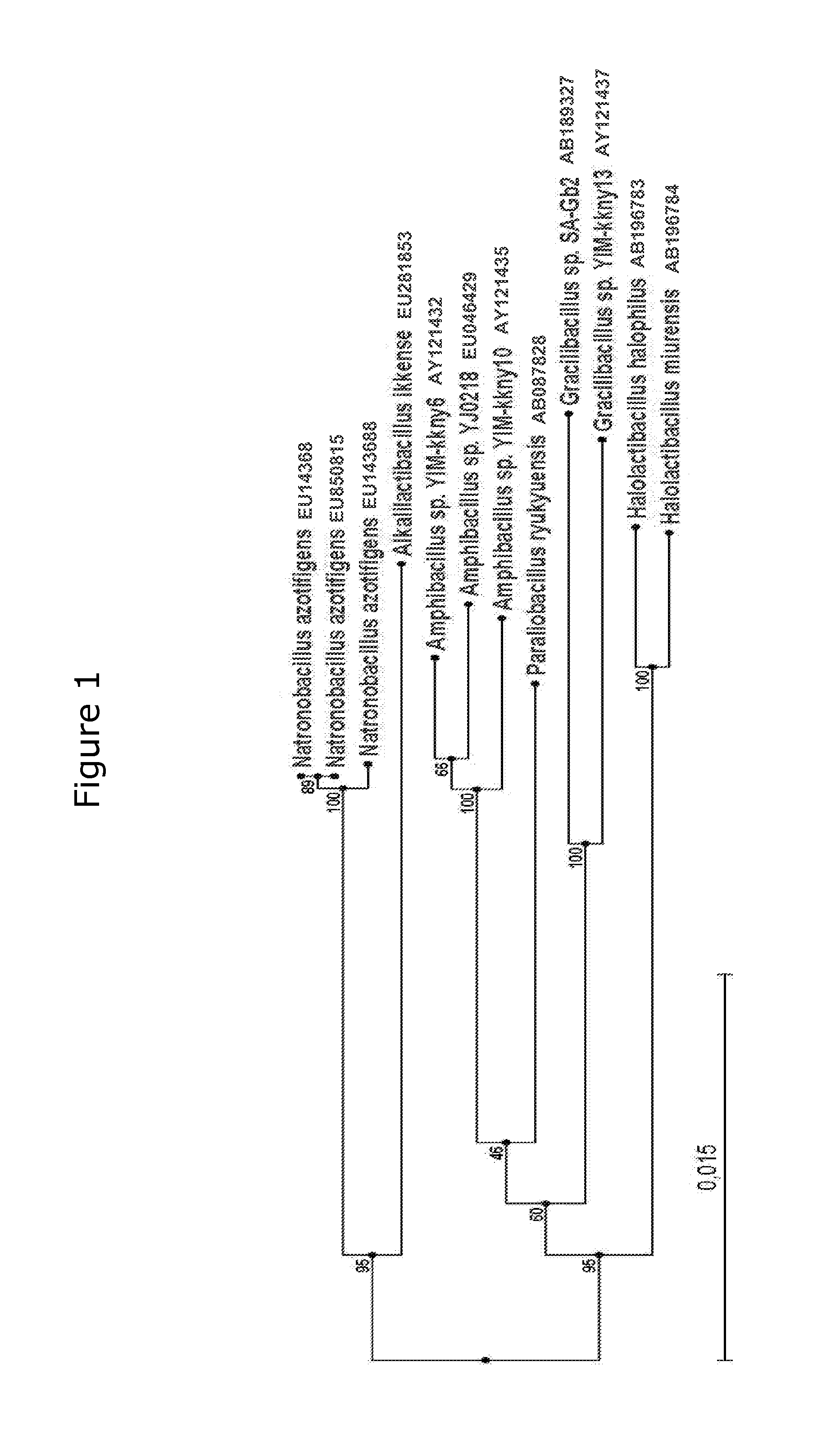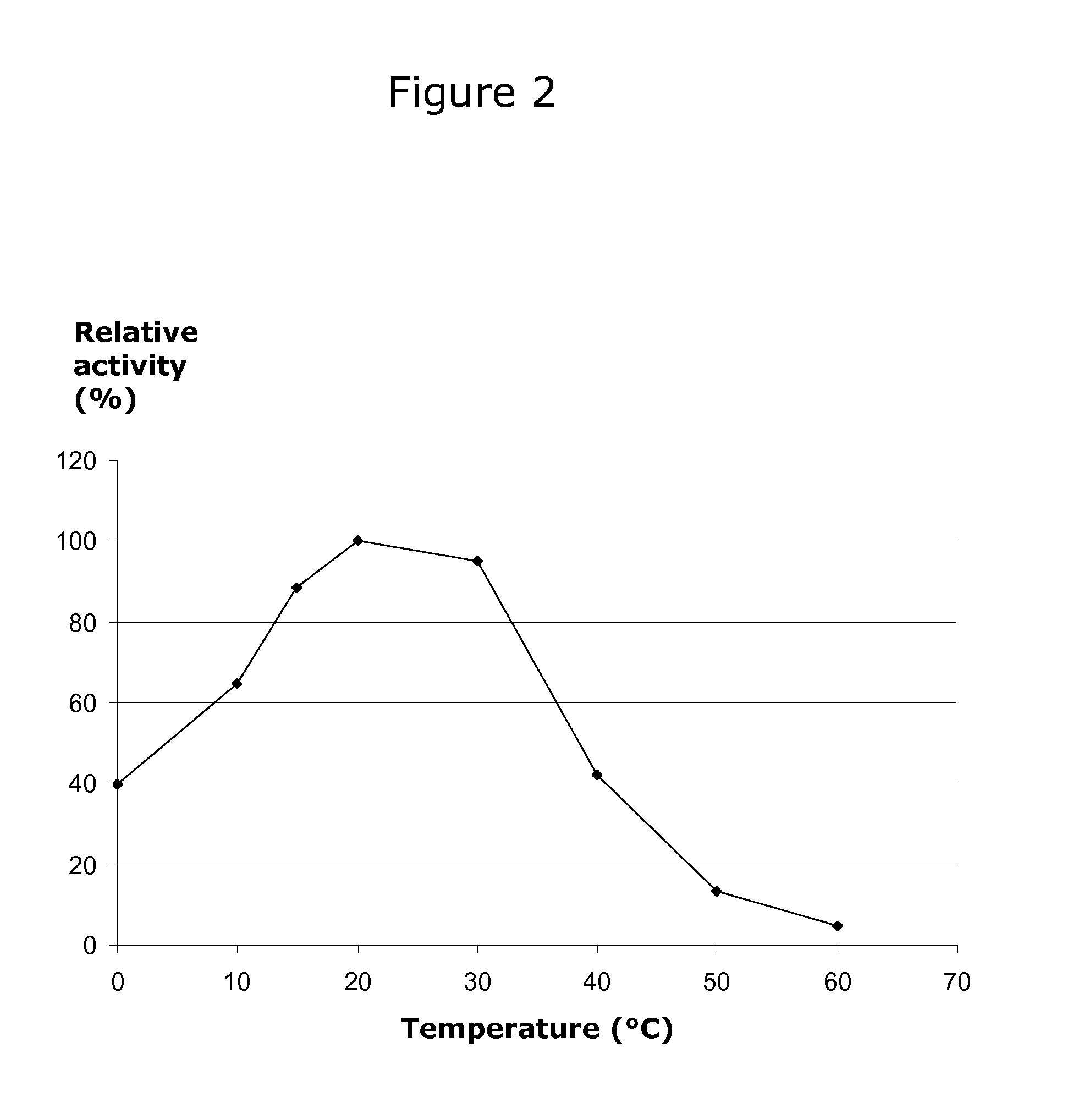Cold-active beta-galactosidase, a method of producing same and use of such enzyme
a beta-galactosidase, cold-active technology, applied in the direction of recombinant dna-technology, carrier-bound/immobilised peptides, botany apparatus and processes, etc., can solve the problem of limited use of conventional beta-galactosidase, putrefaction owing to saprophyte contamination during treatment is a serious problem, and achieves high specific activity
- Summary
- Abstract
- Description
- Claims
- Application Information
AI Technical Summary
Benefits of technology
Problems solved by technology
Method used
Image
Examples
example 1
Isolation of Bacteria Producing Cold-Active Beta-Galactosidases
1.1 Sampling of Bacteria
[0064]Ikaite material was collected by scuba divers in the Ikka Fjord, South West Greenland (61° 11′N, 48° 01′W) from a depth of approximately six to ten meters. The columns were between 36-70 cm in length and between 5 and 30 cm in diameter. The columns were kept cold during transportation to the field laboratory.
1.2 Screening Bacteria for Beta-Galactosidase Production
[0065]Approximately 3 cm3 of ikaite material from a slice 15-18 cm from the top of an ikaite column was drilled out and suspended in 250 ml R2 broth (Schmidt et al. 2006) buffered to pH 10 with 0.2 M Na2CO3 / NaHCO3 buffers as described by Stoll and Blanchard (1990). After incubation at 5° C. for 2 months the culture was inoculated onto R2 medium, pH 10 without glucose but supplemented with lactose (1% w / v), 5-bromo-4-chloro-3-indolyl-β-D-galactopyranoside (X-gal) (40 μg / ml), 10 mM isopropyl-beta-D-thiogalactopyranoside (IPTG) and aga...
example 2
Taxonomical Analysis of Isolate 517 and Description of a New Genus and Species, Alkalilactibacillus Ikkense
[0066]2.1 Phylogenetic Analysis of 16S rRNA Gene Sequences
[0067]DNA for phylogenetic analysis was extracted from cells of isolate 517 using FastDNA SPIN Kit for Soil as described by the manufacturer (BIO 101, Irvine, Calif.). 16S rRNA gene amplification was carried out using the primers 27F and 1492R (Lane 1991), and DNA sequencing was carried out at MWG Biotech AG (Ebersberg, Germany) using the same two primers plus additional primers 519R, 532F, 907F, and 907R (Lane 1991). The near full length DNA sequence of the 16S rRNA gene from isolate 517 was submitted to GenBank / EMBL / DDBJ with the accession number EU281853. Related sequences were retrieved from public databases using BLASTn at the NCBI server (http: / / www.ncbi.nlm.nih.gov / blast / ). The closest related 16S rRNA gene sequences were aligned using the Clustal W multiple alignment program MegAlign 5.03 (DNASTAR, Inc., Madison...
example 3
Characterization of Native Ikka-Beta-Galactosidase from Alkalilactobacillus ikkense
3.1 Beta-Galactosidase Assay.
[0071]Beta-galactosidase activity was assayed by hydrolysis of o-nitrophenyl-beta-D-galactopyranoside (ONPG) and measuring the absorbancy of the released o-nitrophenyl (ONP) compound in a spectrophotometer at 415 nm. In the assay, the release of ONP from 1 mM ONPG by the recombinant beta-galactosidase activity was measured at 415 nm at 20° C. and pH 7.0 (0.1 M NaH2PO4 / Na2HPO4). The reactions were stopped by adding 300 μl 0.6 M Na2CO3. Assays were performed at 0, 5, 10, 20, 30, 40, 50, and 60° C. for 30 minutes. The sodium phosphate buffers were pre-heated to the respective temperatures prior to assay start.
[0072]Thermostability analysis of the enzyme was carried out by placing an aliquot of enzyme at temperatures 0, 10, 20, 30, 40, and 50° C. and taking samples at t=0 to t=24 hours. Immediately after taking the samples, they were cooled and assayed at 20° C. as described ...
PUM
| Property | Measurement | Unit |
|---|---|---|
| temperatures | aaaaa | aaaaa |
| temperatures | aaaaa | aaaaa |
| temperatures | aaaaa | aaaaa |
Abstract
Description
Claims
Application Information
 Login to View More
Login to View More - R&D
- Intellectual Property
- Life Sciences
- Materials
- Tech Scout
- Unparalleled Data Quality
- Higher Quality Content
- 60% Fewer Hallucinations
Browse by: Latest US Patents, China's latest patents, Technical Efficacy Thesaurus, Application Domain, Technology Topic, Popular Technical Reports.
© 2025 PatSnap. All rights reserved.Legal|Privacy policy|Modern Slavery Act Transparency Statement|Sitemap|About US| Contact US: help@patsnap.com



